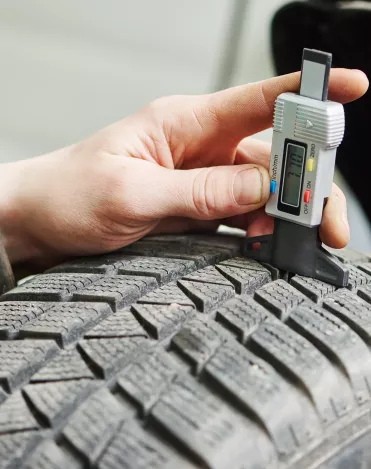How to check your tyre wear and tyre tread depth?
Your tyres are the only component that keeps your car connected to the road while driving. They ensure your safety by gripping the road and also by avoiding excessive braking distances. That is the reason why it is necessary to inspect their condition on a regular basis. If you are wondering “How do I check tyre wear?”, here are some tips to help you recognise if something is wrong.

How do you tell if a tyre is worn?
Tyres can quickly become worn down with regular use, and it is important to check them regularly in order to make sure that they remain in good condition. To tell if a tyre is worn, look for signs of uneven wear, such as bald spots, bulges or tears in the tread, or cracks in the sidewall. If any of these are present, it is time to replace the tyre. If you need more information, ask your local Point S expert to check if your tyres are safe for driving and if they need to be replaced.
Is it safe to drive with worn tyres?
Driving with worn tyres can be hazardous, as it can affect the vehicle's grip and lead to a loss of control. Worn tyres can also cause the brakes to take longer to stop the car and may increase the risk of aquaplaning in wet conditions.
This is why we strongly recommend to regularly check your tyres, whenever you set off for a long journey. If you have any doubt about your tyre wear, please refer to your local Point S centre. Our expert technician will take a closer look and perform a free tyre check to ensure your safety!
Do front tyres wear quicker than rear tyres?
Yes, it is true that front tyres wear quicker than rear tyres. This is because the front tyres are responsible for the steering, cornering, and braking of the vehicle. As a result, they experience more friction and wear than the rear tyres which are mainly used to propel the vehicle (this is the case for front-wheel drive cars, but not for rear-wheel drive cars).
How to check tyre wear?
Point S tyres or any other brand have tyre wear indicators. A tyre wear indicator is a small, raised rubber bar located inside the tread of a tyre. Its purpose is to alert the driver when the tread depth of the tyre has reached a level that is deemed unsafe. When the tyre wears down to the level of the indicator, it is time to replace it. They become noticeable when the tread is thinned to 1.6mm depth.
Another method to check your tyre wear is using a 20p coin. To perform this test, insert the 20p coin into the groove of the tyre tread and see if the tyre tread covers the outer band of the coin. If the outer band is visible, it is an indication that the tyre is worn and needs to be replaced.
What can cause excessive or uneven tyre wear?
Tyre wear can originate from two main reasons. On the one hand, it can be a “natural” wear of the tyres due to all the miles they have been driven. The miles your tyres will last depending on your tyre maintenance and your driving habits.
On the other hand, the type of wear on your tyres can warn you of deterioration or wear on another components of your car that affects your tyres.
For these reasons, it is essential to regularly inspect the wear of your tyre!
Internal tyre wear causes
Internal tyre wear is caused by a variety of factors including over-inflation, under-inflation, misalignment, and overloading. Over-inflation causes the centre of the tyre to wear faster than the edges, leading to a cupped appearance. Under-inflation causes the edges to wear faster than the centre, resulting in a flat-spotting effect. Also, uneven tyre pressures, can cause the tyre to wear down in an irregular pattern.
Finally, overloading the tyre can cause premature tyre wear due to the increased pressure on the tyre.
Tyre alignment troubles
Tyre wear can be caused by several factors, but one of the most common causes is misalignment. Misalignment can cause uneven wear on the tyres, resulting in excessive and premature tyre wear. It is important to have your tyres regularly aligned to ensure that your tyres have an even wear pattern and last for their full lifetime.
External tyre wear causes
There are different kinds of external tyre wear, each one with different causes:
- Early wear on the tread: could be from an insufficiently inflated tyre;
- Wear in the centre of the tread: the tyre could be over inflated or damaged due to excessive speed;
- Wear of a single shoulder: could be from a mis-alignment;
- Uneven wear: could be from a mis-alignment, certain suspension parts (dampers, steering) that need to be adjusted or replaced.
In summary, checking the wear of your tyres improves your safety on the road.
For more information and advice, make an appointment directly with one of our experts!
Is outside tyre wear illegal in the UK?
In the UK, legal tyre wear is defined by the minimum tread depth of 1.6mm across the central three-quarters of the tyre. If any area of the tyre has a tread depth of lower than 1.6mm, then it is considered illegal and must be changed as soon as possible. The penalty for driving with illegal tyre wear in the UK is a fine of up to £2,500 and 3 penalty points on the driver’s licence.
What's the legal minimum depth of tread for car tyres?
The legal minimum depth of tread for car tyres in the UK is 1.6mm. This means that the tread depth should measure at least 1.6mm in the central three-quarters of the tyre’s tread width and around its entire circumference. If the tread depth of a tyre is below this limit, the tyre is considered to be unsafe and should be replaced.



